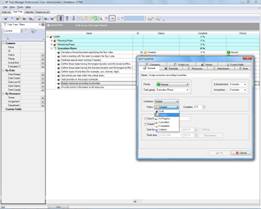|
Successful implementation of the previous, Planning phase allows you to avoid contingency through placing completion buffers on your project schedule. It means that any unexpected delays are buffered so project due dates are protected. Now the manager of your project can lead the team to the next, Execution phase.
"Execution" is the second phase of the CCPM lifecycle. Its purpose is to start the task implementation process by allowing your project team to execute tasks of the critical chain according to the schedule and with reference to scheduled buffers. The key emphasis of the phase should be placed on resource behaviors to induce the team to start doing the tasks as planned and eliminate or at least reduce waste of time and multi-tasking (especially for the drum resource - it is a resource regarded as a constraint throughout the project).
Itâs convenient to manage the Execution phase by planning a range of tasks that represent key activities of the phase. With help of VIP Task Manager you can develop to-do lists, templates and checklists of tasks. Please read on what key activities you need to undertake within the Execution phase and how VIP Task Manager can be helpful for managing typical tasks of the phase.
Five Basic Rules
The Execution phase of your CCPM driven project will be successfully accomplished if your project manager and especially the team stick to the following five basic rules:
- No multi-tasking - if someone starts doing a critical chain task, he/she must stick to the task until successful completion. The key idea of this rule is that people who multi-task waste a lot of time when switching between two tasks. Putting a ban against multi-tasking generates extra capacity.
- Resource-dependence - you must start doing a critical chain task as soon as a needed resource is available to you and prerequisite tasks are completed.
- Subordination to the critical chain. Every non-critical activity has always a lower priority against any critical chain task. It means that you need to prioritize critical chain tasks and consider priorities when beginning a task.
- Early start - you must start a task as soon as possible. The rule fights the Student syndrome causing situations when a person delays the start of work until he/she absolutely has to do the start.
- Early finish - you must complete a task as quickly and aggressively as you can do it. This rule creates extra schedule capacity allowing you to benefit from early start of following tasks.
Before your team members start doing any task, the manager needs to guide them through these rules in order make sure they clearly understand the rules and are ready to stick to them. Meetings will help address this issue. During a team meeting your project manager can present configuration of the critical chain, determine key priorities for tasks of the critical chain, and describe team behaviors. When you think the team is ready to do critical chain tasks, you can start managing buffers of your project.
Setting up Priorities
The CCPM methodology requires using prioritization as a flexible technique for allocating resources among tasks of the critical chain. The point here is that when a resource (a team member) has clearly assigned priorities, he/she can do tasks in a sequence defined by the project schedule. When all resources of your project focus on the right sequence of tasks, they greatly contribute to saving the "health" of the critical chain, including associated buffers. Hence, the whole project is being developed on schedule.
Prioritization has also another purpose. It helps avoid multi-tasking. Properly set priorities prevent a resource having more than 1 task open from trying to focus on another task. Prioritization allows the resource to follow the "roadrunner" approach. It means that if thereâs work available the resource will try to complete this work at the fastest possible pace (while with no quality compromised) until successful completion. More over, as the methodology requires reducing estimated task durations twice, the resource has to remove the temptation to multi-tasking and start meeting the more "aggressive" durations.
The manager of your project needs to prioritize tasks of the critical chain by durations and associated buffers. A task with the shortest completion time and the lowest buffers should be assigned to a higher priority. On the contrary, a task with the longest buffer length and duration should have a lower priority.
Using VIP Task Manager
With help of VIP Task Manager, all the activities of the Execution phase can be represented as a range of tasks organized by groups. The software features Task Tree view to create to-do lists, project templates and hierarchies. For example, the manager of your project can develop a hierarchy of tasks assigned to team members. Every task has a range of attributes such as Name, ID, Priority, Status, Due Date, Start Date, % Complete, Attachments, and others. Below you can see an example of task hierarchy for the Execution phase. Please look at the screenshot to see how Task Tree view re-creates those tasks.
Execution Phase 
- Develop a formal document specifying the four rules.
- Hold a meeting with the team to explain the four rules.
- Dedicate special team training if needed.
- Define those tasks having the longest duration and the lowest buffers.
- Define those tasks having the shortest duration and the longest buffer length.
- Define types of priorities (for example, Low, Normal, High).
- Set priority per task within the critical chain.
- Add priorities to the project schedule.
- Assign resources according to priorities.
- Provide priority information to all resources.
The manager of your project can use Priorities in VIP Task Manager to prioritize tasks of the critical chain. Thereâs also Resource Assignment Panel to assign prioritized tasks to resources. The manager can use both tools of VIP Task Manager to limit team behaviors and hence to fight the Student Syndrome.
|